Vibram resoling: Rescuing my ‘grail’ Nike ACG hiking boots
By Tony Sylvester.
I am sure you too have a full and eclectic ‘Saved Searches’ section on your eBay app. Mine includes everything from rare Barbour jackets to Finnish glassware; old Polo coats to Georgian jewellery. Some are comedic reminders of spur-of-the-moment rabbit hole dives, others tributes to long-standing obsessions. Occasionally, they even lead to the landing of a white whale.
Recently, something along those lines came up that seemed to be an unbelievable eBay 'bargain'. A deadstock pair of 1990 Nike hiking boots appeared in my size with the ‘buy-it-now’ price of £10. I couldn’t believe my luck, until closer inspection revealed the reason. While the uppers and sole were indeed completely unworn and box fresh, the midsole had crumbled away with age, a common ailment with footwear of this vintage, making them unwearable.
The seller acknowledged this in the listing, suggesting they were “for display purposes only”; this was no doubt the reason for the super low list price. I weighed up my options for a couple of minutes and placed an offer for £8 for the grail item. Within minutes I was the proud owner of a completely useless pair of 33-year-old hiking boots.
So, a gauntlet had been thrown down. In the spirit of both thrift and sustainability, would I be able to repair the boots in the same way as Goodyear-welted dress shoes? The care, upkeep and rebuilding of clothing is something that Simon has covered in depth on Permanent Style, from the darning of socks to the best ways to store and maintain cashmere. Could the same care and attention be brought to these redundant boots?
I’ve always had a soft spot for Nike’s ACG (All Conditions Gear) sub label, and its antecedents. Nike’s history with the category of footwear goes back a long way: having focused primarily on running shoes in the early seventies, by the end of the decade it had turned its attention to more rugged pursuits. In a similar manner to its innovatively lightened running shoes, the hiking boots shed the clumpy heaviness of prevailing styles while retaining the necessary toughness.
Climbers Rick Ridgeway and John Roskelley started the move by conquering K2 in 1978 in pairs of heavily trashed and repaired Nike ‘LDV’ running shoes (above). These were far removed from the bulky leather alpine boots of their forebears, and the design team at Nike set about trying to create a model specifically designed for climbing and hiking, but with a similarly slim silhouette.
The colourways of the resulting boots paired earth tones with flashes of contrasting colour to beautiful effect. They deliberately echoed the rugged hippy-inspired style of seventies climbers - a look I would like to delve into closer in a future PS column. The late great streetwear and culture writer Gary Warnett of Gwarizm described the ACG range as “merging a rustic breed of beard-friendly gear with state-of-the-art technologies and a fair amount of whimsy."
Unboxing my eBay boots was bittersweet. The colour and styling were perfect: although not as loud as the usual ACG colourways, the true olive grey/green is offset by an embroidered logo of pleasing teal, and the condition, as advertised, was immaculate.
Seeing the degradation of the midsoles was heart-breaking, however, and sadly unavoidable with trainers of this vintage. Sneaker designer Chris Law explained to me that this is due to oxidation of the EVA and comes from storing them in damp environs, like an English loft for example. Trainers from the mid-eighties and before were more likely to have rubber soles, so this is not a problem, although rubber will harden over time instead.
So what was my next move? I didn’t buy the boots to sit under a cloche on a pedestal. In pursuit of ’10,000 steps a day’ and in appreciation of the coastline of East Kent - where I now live - I wanted the boots to perform the task they were built for. Fortunately the high quality of shoes from this era (as Law put it “what is considered premium now was standard in the past”) means that resoling is a viable option.
My first port of call was Tony’s Heel Bar in Kentish Town. They are still the go-to people for my resoling and repairing, and provide their services to all London shoemakers.
Speaking to Tony, he felt this was a specialist job that might be better taken care of by an expert, so I called Will Stowe, presenter of the Nike ‘SNKRS’ podcast for his input. He told me I had two options: a full “sole swap” - a specialist procedure where the entire sole unit from a similar shoe is swapped onto your upper by a custom restorer. Or, a resole with a generic sole from another company that was as close / simpatico as possible.
The use of the custom sole swap appeared the most reverential to the boots, and I was recommended to contact Kyle Smith from KS customs.
Here, Kyle said the key was finding a viable alternative sole that would fit the upper, with the recommendation of a sole post-2018. He suggested the Air Jordan IV as a suitable candidate. The cost would be £150-200 for the labour, plus the cost of the donor shoe for the sole removal. My rash purchase was beginning to spiral out of control, with a potential bill of £400 plus for some usable kicks. A generic resole started to look more appealing.
Further research took me to the rather lofty sounding Vibram London Academy on City Road. Opened in 2016, this East London outpost of the Italian rubber-sole manufacturer offers repairs and resoles on all kinds of footwear, providing you choose from their range, which comes in a dizzying array of colours. Everything from boat shoes to trainers, work boots to dress shoes can be handled.
Their best option was the Bristol - a generic hiking boot sole with a thick chunky tread and an extremely high midsole, which seems to envelop most of the upper. Despite some jazzy two-tone choices, I opted for the black, with a price tag of £79 for parts and labour and a four-week wait. It seemed I would get my boots after all.
As promised the boots were back at the shop within a month and ready to test drive on the chalky cliffs of winter. I was very happy with the results - a stout, handsome pair of boots with a resonance of nostalgia for the stylings of my youth.
Are they perfect? Well no. But what I want is unattainable: the exact shoes of the period in wearable condition at a realistic price point. One of the great selling points of the original models was their toughness combined with a slimmed down silhouette. Having to use the generic Vibram Bristol sole has undermined this aesthetic purity a little.
But, I now own ‘brand new’ boots in an iteration I will likely never get the opportunity to buy again, for a price tag south of £100. All in all, a worthwhile pursuit.
For those seeking that elusive sleeker look, may I recommend New Balance’s Mount Rainier reissue, Paraboot’s Yosemite model or the Danner Jag boot (pictured below, in that order).
For styling, I pair mine with the Bryceland’s Foul Weather Anorak in a heavyweight Kersey cloth, and a pair of corduroy walking trousers that I unearthed from the bottom of a stack at San Francisco's Cable Car Clothiers, another rare and slightly eccentric piece of deadstock.


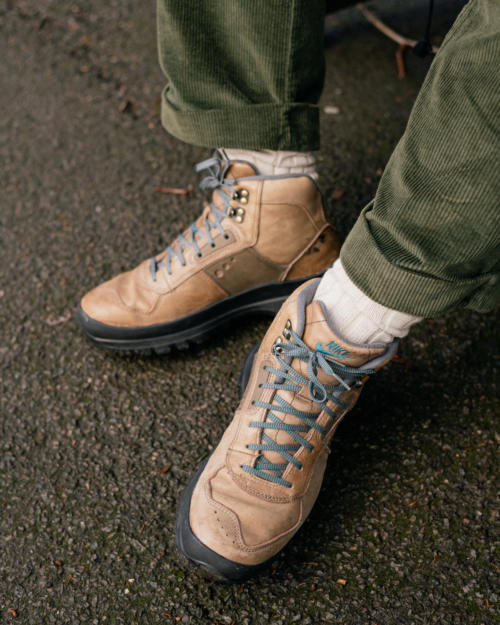
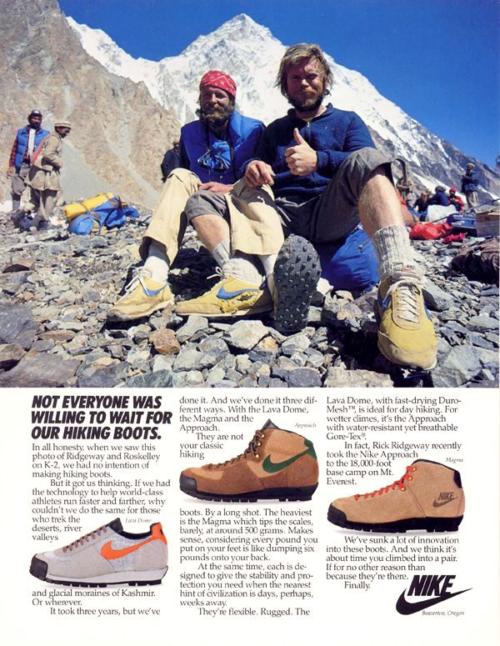
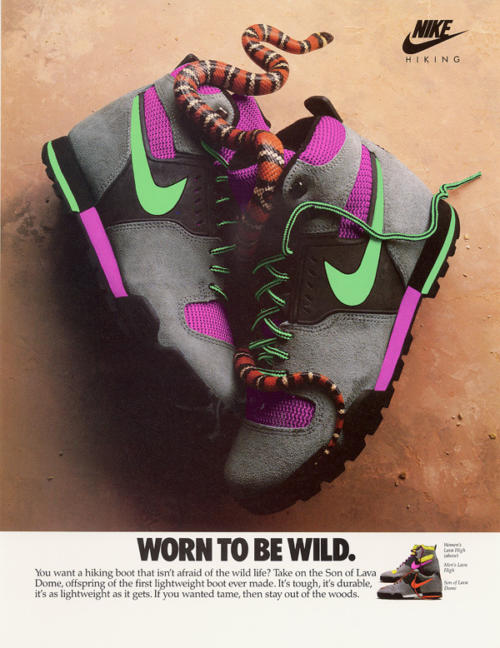
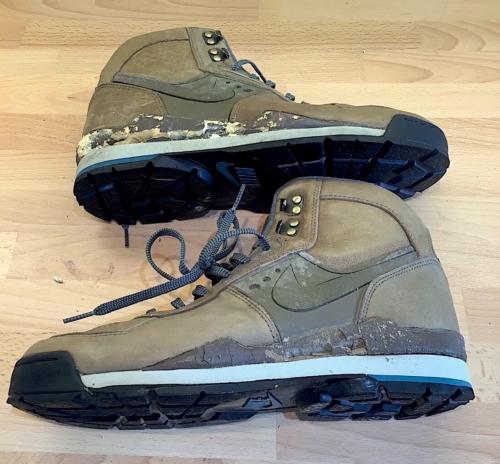
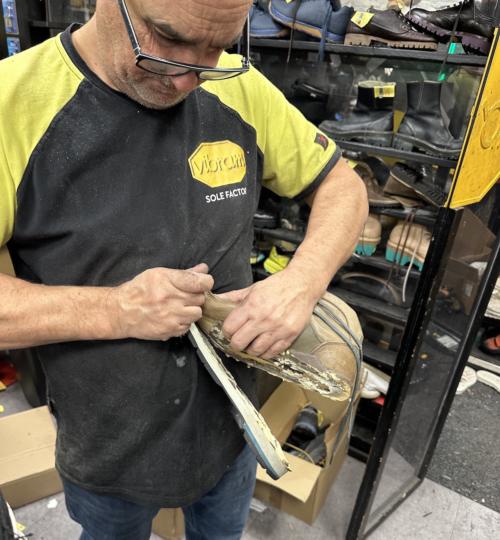
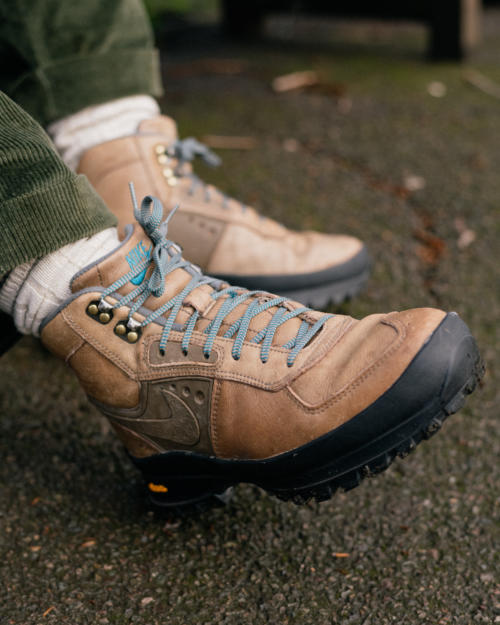
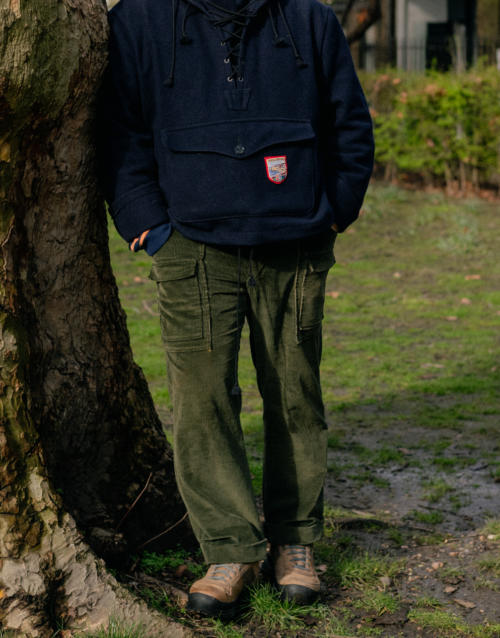
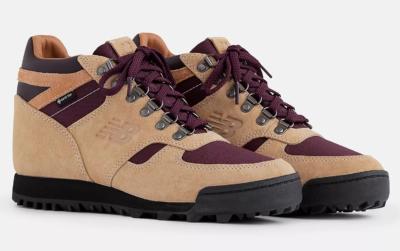
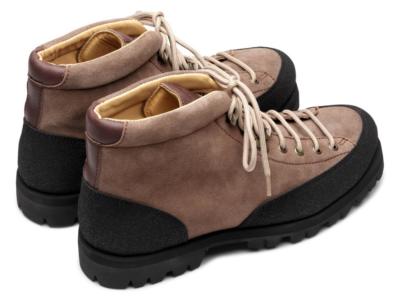
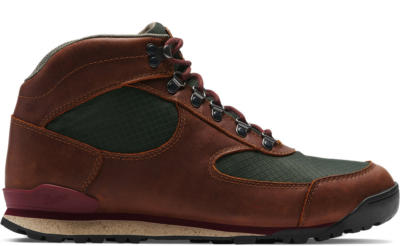


























For what it’s worth, I think that the generic re-sole was the right choice. It seems, in part at least, to undermine the value of vintage shopping if you have a wreck a new pair of shoes in the process. And now you’ve got something unique and with a bit more of a story.
Lancashire Sports Repairs in Burnley has been recommended to me by several retailers. The company can replace several leading brands’ boots (such as Danners) or trainers with the original sole units for £85. Alternatively, they’ll resole with a compatible Vibram unit for £65. Return postage is £9 so the total cost is close to what Tony paid.
Those who want to go hiking or climbing should avoid fashion brands like Nike, New Balance and Timberland. Choose a specialist brand such Altberg, Scarpa, Meindl or Lowa who supply the armed forces and police. Those brands’ product offer better support, construction and durability which are more important thank looks or aesthetics. It takes months for a broken ankle or torn ankle ligaments to heal properly.
Altberg is a Yorkshire manufacturer based in Richmond. Importantly, it offers a choice of widths and fits. The Tethera and Fremington (BBC Countryfile’s favourite) are available in 5 widths and half sizes so you should be able to get the perfect fit. There is a fitting service at the factory or phone advice if necessary. Hope this helps.
Thanks Gary. It would be interesting to have some information sometime on exactly how much models from some of these better-known makers can be used – eg lighter hikes – from someone that has used both. We’re not talking fashion hiking boots after all, they are designed for use.
Altbergs are very good-I used them for many years in the armed forces.Customer service is always good. I have a pair for high level walking and they have never let me down.
Salomon make very good trail shoes which always do well in surveys. Mine are the GTX 4.
For most uk walks a good pair of trail shoes (with gaiters) will see you ok. Salomon would be my choice especially those with a breathable lining..
I would always use a boot from a specialist maker ie. those listed by Gary, as you really need the arch/ankle support and shock absorbtion.
Usual rules-buy from a shop and be fitted. Have your fitting in walking socks and wear your rucsac
Thanks Peter
The manufacturer’s website will say what a particular model is suitable for. Different models are suitable for hiking, hill walking and climbing steep mountains. Sometimes, you will need different pairs for the approach and the climb itself. The descent is often the most dangerous part of the expedition and demands respect.
For tough conditions in harsh weather, e.g. snow and ice, the boot may need to be compatible for wearing crampons too. If in doubt, seek advice from a boots specialist with years of practical experience, e.g. in the factory or in a reputable retail outlet. Watch out for the young shop assistants in the big chains who often know little or nothing. They are only interested in a quick sale to earn commission or bonuses.
Cheers Gary. Yes I’m more familiar with these types of boots, but I meant to what extent could the boots from the bigger brands be used for different activities. If you haven’t, it would be interesting to hear from someone who has used them for different types of excursions
I am not sure what you mean by “excursions”. Tony’s resoled boots are fine for hiking and hill walking but not mountain climbing. The others pictured are only suitable for normal urban/town casual wear and country/park/riverside walks. Unusually, the New Balances look uncomfortable to my eyes. The Paraboot lacks ankle support and the Danner sole is too thin.
I always choose footwear that is the best for the activity. e.g. KSwiss for racquet sports, New Balance for running (both recommended by our podiatrist) and Sebago Clovehitch for sailing. To do otherwise would risk serious injury. Most trainers are not suitable for playing tennis or running. Most boat shoes are not suitable for serious sailing. I would not use them even on a dinghy, barge orcanal boat. My advice is not to use any footwear for multiple activities.
Thanks Gary. Hiking and hill walking probably covers it, and obviously the less specialist the activity, the less I would have it will be an issue reusing other footwear.
As I said, I’d be interested to hear from anyone that has used the non-specialist brands for different things
Well,my salomons,for example, are really a waterproof trainer,so they get plenty of use with grandkids in the park plus ideal for wet days on the scooter.
I think for maximum versatility a gortex membrane helps and they are a good holiday shoe.
I wear them for pretty much anything where smartness is not an issue but want to avoid damage to my better footwear. The lightweight trail style, with membrane is pretty standard now.
Thanks Peter
I can give some input from hiking in the Alps. The big makers (Nike, Adidas) are usually not good once you hit rocks. The main problem usually is that you do not have much ankle support resulting in sprained ankles. Further, their built is too light to protect feet against abrasions. Much better to stick with specialist makers like Dachstein, Loewe or Scarpa. I think the main issue is that you cannot buy a really good hiking boot below EUR 300, and Adidas or Nike have a different Price Target.
Thanks Markus
Simon,
We do a fair bit of mountain hiking in the PNW (up to 10 miles and 4500ft of elevation gain – that’s about as much as our kids can handle). Switching to specialist brands (LaSportiva & Merrell in our case) has been a big step up in terms of ankle stability, comfort in mud/snow and (most importantly) grip on steep hills. I wouldn’t go back to the more generalist boots I had before.
Thanks Philip
It comes down to R&D and target market. The non-specialist brands devote all their R&D to design, and their target market is streetwear. I wouldn’t even use Nike or Adidas shoes for trail running. They’re just not up to it.
Even within the ‘tactical’ market, non-specialist brands will fail dramatically. I’ve seen 5.11 assault boots reduced to a soggy mess twelve hours into a hike, with a badly sprained ankle six hours into it.
I’ve used Mil-Tec boots (because that’s all I could afford) on hilly, rough terrain. They’re fine for ankle support, but after a couple of years, the soles are worn flat, and cuts have opened up on the sides. The sole rubber is just too soft, and the suede is too thin and fragile.
Ditto U.S. issue desert boots. The sole is not designed for hard surfaces.
Thanks JF. Good to have the personal experience, though it’s certainly not the case that Nike and Adidas devote all their R&D to design. Talk to someone who works in Adidas’s bespoke lab some time
If I may chime in with a slightly related anecdote: my brother was wearing some Nike trail runners when we approached Glacier Peak in the Pacific Northwest two years back. He had no troubles despite the long distance or rugged terrain, and reported they’d be his shoe of choice for such excursions in the future despite his access to more specialized brand’s footwear. He did change into Arc’teryx boots for the more technical summit push. I was happy with my La Sportiva shoes and boots for the trip. A word of caution: regardless of footwear, we cannot recommend crossing snow at elevation in shorts. The sunburn was florescent.
Cheers Andrew, that is helpful
For what we Canadians call “day hiking” (i.e. a small rucksack and a walk that can be completed in one day) Nike and other light hikers are fine. For true backpacking involving multi-day trips a pair of sturdy hiking boots is essential. I have a pair of Hanwag (a German company) boots that have served me well for many years.
+1 to Hanwag for high Alpine usage
Back in the 90´s my hiking boots were Hi Tech Sierra Lite (almost identical to NB Rainier), in my opinion they performed very well. They weren´t waterproof, but in the other hand they were very breathable and dried quickly if wet. I must say I live in the South of Spain so not much rain around here…
Interesting, thank you Adrian. It’s kind of what I suspected, that technology advances and equipment is better these days in lots of ways. But at the same time, you’re unlikely to do yourself serious harm if you use slightly older technology, because few people did then either.
Just picking up on Gary’s comment, and admitting this is relatively unrelated to Tony’s interesting piece, as well as admitting that his unique boots are probably fine for climbing the cliffs of Kent, I would like to put in a word for some great hiking boots that I picked up last year and that I think could be of interest to many PS readers with outdoorsy interests: https://limmerboots.com/ of Intervale, New Hampshire.
These are super-sturdy well considered traditional hiking boots built in great leathers with Norwegian welt construction. They are tough enough for serious multi-day hikes with heavy loads in complicated terrain, yet good-looking enough to be worn with most workwear.
They offer a bespoke service with boots made in Intervale, but also offer RTW boots made by Meindl in Germany to Limmer Boots’ specs (I got the latter).
Living in Scandinavia, I was remotely fitted by owner (and Chief Hiking Officer) Chris Sawyer using a quite impressive guidance for measurements developed by them. The resulting fit was spot on.
A great project and as always, an entertaining and informative read. I very much look forward to reading your take on 70s climbing style! I have always appreciated the style of climbers…there is usually a pleasing blend of flair, function and performance in there.
I think I actually prefer these with the resole – whilst they lose some slimness to my eye they look better balanced.
Also for some reason the Danner link leads to a review of a hopsack jacket.
I’m going against the PS grain here but if you like that look the newish Nike Tom Sachs General Purpose Sneaker might be for you.
Already picked up a pair in brown! Thanks Gus!
…which can’t be bought anywhere apparently and unfortunately.
What. A nice a story thank you for sharing
Hi Tony,
An interesting and enjoyable story, with a unique shoe at the end. Specialist pursuit’s aside they simply look nice.
I wouldn’t say necessarily sustainable, as even repair, and without economy’s of scale, comes with a carbon footprint. Not a criticism just sustainability at this level (IMO) isn’t really a driving factor.
Focusing on the end product , it’s something special and meaningful to you which is a great outcome.
Any chance you could do something on climbers rugby shirts at some point?
I don’t climb, I just like them in the same way I like Belstaff (a jacket possibly worth of your attention at some point?) but don’t ride a motorcycle.
All the best.
Having something literally no one else has is always a worthwhile pursuit! They look great. I have a pair of Danner Jags that I love.
Scarpa and La Sportiva for hardcore mountain boots and approach shoes.
These Nike remind me of my Dolomiti Karakoram boots.
A great story. I love the slender aesthetic of these original lightweight boots, but for actual use, I personally find old fashioned high-ankled Alpine boots with heavy leather and vibram soles unbeatable. Asolo’s TPS 520s are the best available at a reasonable price point. They’re heavy and clunky, but the leather is supple and they’re made in Europe (Romania, I think, though still marketed as Italian). The one time I’ve bought Chinese-made hiking boots was a disaster, the leather stiff enough to be painful on long downhills. The TPS 520s can handle everything from walking the dog on the towpath to serious hiking with a fifty pound pack. I’ve put well over a thousand miles on the pair I’ve had for just over a decade and they’ve performed as well on scree slopes in the Julian Alps as in a sudden snow squall in the Cairngorms and wore them just yesterday in the garden. And they can be re-soled, though I’ve not done so yet.
For US readers: Red Wing, Alden, Wesco, and White’s will factory resole your boots, and if you’re fortunate enough to live by a store you can drop them off. Note that while Red Wing, Wesco, and White’s will do any sole you want, Alden will only replace the current sole, e.g. you can’t request a flex sole to be resoled as a commando sole.
I had a pair of £100 Grisport Quatro boots which have walked over 2,200 miles. The soles are as tough as, well as tough as old boots. In fact, the only repairs have been to a worn heel area. I expect another 1,000 miles in due course. I have a second unworn pair of Grisports, which I have decided to sell as I am now running more. My previous £40 Hitech hiking boots did 1,800 miles. The number of blisters from both pairs I can count on one hand. I also have previous experience of bad boots. A pair of bad or ill fitting boots will not make 100 miles.
Addendum: Half of the miles have been with a 5-8kg backpack and should my Grisports make 3,000 walking miles that will be over 1,000,000 calories expended from a single pair
Take it from an experienced climber: Never, Never, Ever wear re-soled boots in a wilderness area. They WILL eventually fail on rugged terrain, and you’ll be stranded.
Even with new boots, I still always take zip-ties and half a reel of gaffer tape with me into the outdoors. It is agonising to walk in broken boots, and it plunges you immediately into an emergency, where your survival is at stake.
Your boots are your first-line survival gear. It’s never worth the risk. No guarantee from the repairer can save you in the remote backcountry.
Don’t do it. Buy new Loewas and be safe. Nothing you will ever buy is more worth the money.
Meant kindly,
Simon Romanos
Thanks Simon, though worth noting the article isn’t about this kind of use
It’s only fair to point out that Tony wrote “Climbers Rick Ridgeway and John Roskelley started the move by conquering K2 in 1978 in pairs of heavily trashed and repaired Nike ‘LDV’ running shoes (above). These were far removed from the bulky leather alpine boots of their forebears, and the design team at Nike set about trying to create a model specifically designed for climbing and hiking, but with a similarly slim silhouette.”
In fact, the climbers would have worn the Nike running shoes on the approach to K2. Anyone with even basic climbing experience knows that there is no way that Ridewway and Roskelley could have reached K2’s summit in them. Even the Nike ad above does not make that claim. However, the company entered the climbing boot market as a result so it perfectly reasonable to question whether Tony’s resoled Nike boots are suitable for use in such tough conditions.
Thank you Gary, yes appreciate the difference and the fact the shoes could not have been used to reach the summit. But I can still imagine many insisting that a trainer like that was inappropriate for the approach too
If you cannot use a thing, then it’s lost its integrity.
Awesome. The “generic” Vibram sole makes this pair of Nikes unique to you. I’ve many pairs of boots that I’d like to get re-soled one day, but I don’t have any reputable cobblers near me in Ohio. I’ll have to just send them off to Vibram sometime.
No new post today?
There is – try refreshing maybe?
Just received a pair of sneakers repaired by Vibram China today. The sneakers were made by Cole Haan and are over 12 years old. The original Nike Air midsole started to crack but the outsole and the rest of the sneakers were fine. At first, I only wanted to change the midsole, maybe replace them with cork, but cannot find anyone locally who’s willing to do so.
Like Tony’s hiking boots, the limited styles offered by Vibram mean the style of the sneakers has changed. But the quality of the job is very good. And great value (RMB399, ≈GBP47).
Nice to have your experience added, thanks Zian
A very good trekking boot salesman once told me that there is no such thing as “the best” boot because all depends on your own feet and gait and thus what works for you. Finding your personal best boot can only come from trials.
In my case that would be my trusty Italian-made Zamberlans which I have owned for decades. I have worn them trekking in and out of America’s Grand Canyon (both rims, many times), along the Great Wall of China, up and down sacred Mount Hua near Xi’an, along the Kwahu Plateau in Ghana and all over Italy where I live. A heel injury has limited me to my bicycle in recent years so the boots mostly sit in my armoire. I hope to die in them anyway.
Nice voice and well written. Thank you! While not pure to the original I thought the resole was an improvement. I’m more open to color in footwear now, but in the 70s and 80s I thought those were ridiculous. Sorry. I tended towards traditional hiking boots and lower stack running shoes. I’ve worn a few iterations of the Pegasus, but about a dozen years ago I began to feel they were overly tall like short stilts, making foot stability nearly impossible even with robust foot and lower leg muscles. Then the platform shoes came to running.
„Are they perfect? Well no“ That is not true! It is perfect! You have created something unique and very, very beautiful. The 3 series models presented by you do not come close!
Brilliant. I am a fan of getting shoes resoled in sometimes different ways. I have had Redwings resoled with a harder vibram sole, chunkier red dainite soles on a pair of brogues previously with leather. It’s often an improvement on the originals.
THOSE ARE GORGEOUS!
And quite timely as I am currently looking into what to do about the separating sole on my twenty-five year old Vasque boots.
The soles really don’t need replacement. Hoping I can do this myself. Suggestions on the appropriate glue would be much appreciated. I’m in the U.S.
THANKS!
Do you sell Nike hiking boots? To the uk?